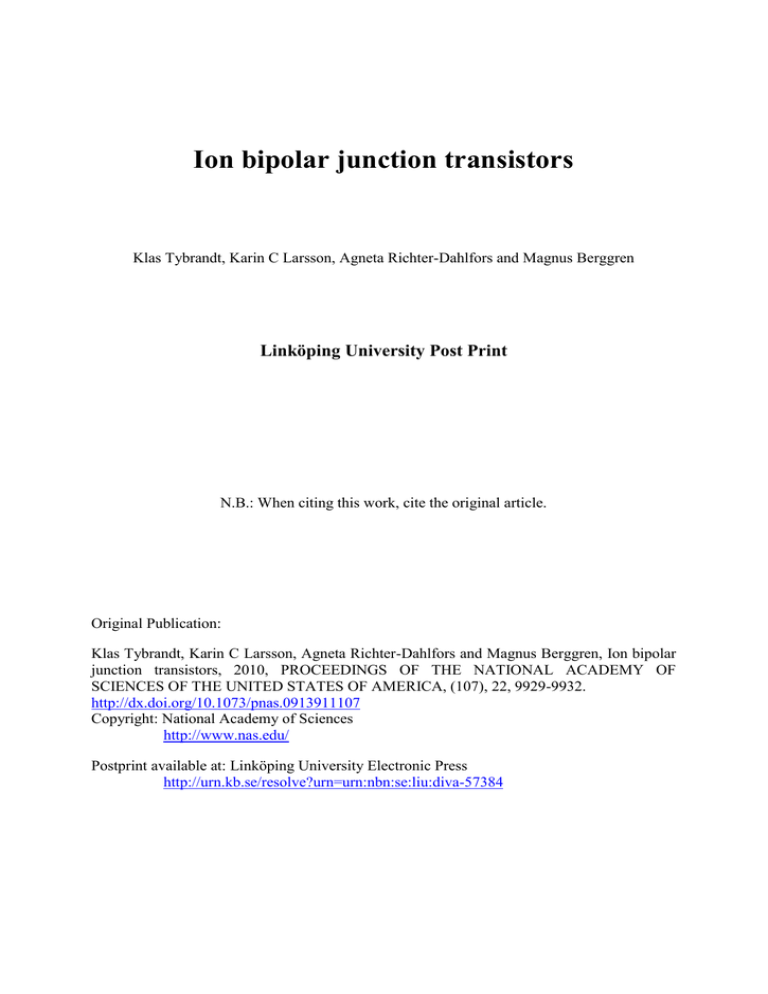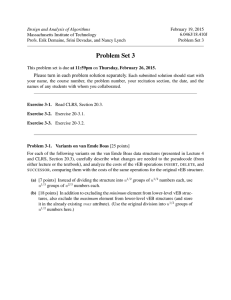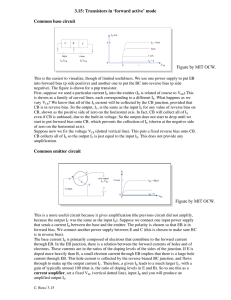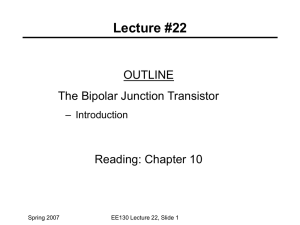Ion bipolar junction transistors
advertisement

Ion bipolar junction transistors Klas Tybrandt, Karin C Larsson, Agneta Richter-Dahlfors and Magnus Berggren Linköping University Post Print N.B.: When citing this work, cite the original article. Original Publication: Klas Tybrandt, Karin C Larsson, Agneta Richter-Dahlfors and Magnus Berggren, Ion bipolar junction transistors, 2010, PROCEEDINGS OF THE NATIONAL ACADEMY OF SCIENCES OF THE UNITED STATES OF AMERICA, (107), 22, 9929-9932. http://dx.doi.org/10.1073/pnas.0913911107 Copyright: National Academy of Sciences http://www.nas.edu/ Postprint available at: Linköping University Electronic Press http://urn.kb.se/resolve?urn=urn:nbn:se:liu:diva-57384 An ion bipolar junction transistor PHYSICAL SCIENCES: Applied Physical Sciences, BIOLOGICAL SCIENCES: Neuroscience Klas Tybrandt1, Karin C. Larsson2, Agneta Richter-Dahlfors2 & Magnus Berggren1* 1 Linköping University, ITN, Organic Electronics, SE-601 74 Norrköping, Sweden 2 Department of Neuroscience, Karolinska Institutet, SE-171 77 Stockholm, Sweden * To whom correspondence should be addressed. E-mail: magbe@itn.liu.se Author to whom correspondence and proofs should be sent: Magnus Berggren, magbe@itn.liu.se, Linköping University, ITN, Organic Electronics, SE-601 74 Norrköping, Sweden, +46 11 363637 (office), +46 11 363270 (fax) Author contributions: Designed and performed research: K.T., K.C.L. Analyzed data: K.T., K.C.L. Wrote the paper: K.T., M.B., K.C.L., A.R-D. Project planning: M.B., A.R-D. 1 Abstract Dynamic control of chemical microenvironments is essential for continued development in numerous fields of life sciences. Such control could be achieved with active chemical circuits for delivery of ions and biomolecules. As the basis for such circuitry, we report a solid-state ion bipolar junction transistor (IBJT) based on conducting polymers and thin films of anion- and cation-selective membranes. The IBJT is the ionic analogue to the conventional semiconductor BJT and is manufactured using standard microfabrication techniques. Transistor characteristics along with a model describing the principle of operation, in which an anionic base current amplifies a cationic collector current, are presented. By employing the IBJT as a bioelectronic circuit element for delivery of the neurotransmitter acetylcholine, its efficacy in modulating neuronal cell signaling is demonstrated. 2 \body Numerous biochemical, biomedical and clinical applications demand technology allowing for the spatiotemporally controlled delivery of ions and biomolecules. In order to gain dynamic control of cellular microenvironments, substance delivery in complex highresolution patterns where each point of delivery is individually addressable is required. In analogy to the addressing schemes found in active matrix displays (1-2), addressability in active chemical circuits can be achieved by introducing transistor functionality into each delivery point. Transistors are generally three-terminal devices in which the current between the first and second terminals is controlled by an electric signal applied to the third. The semiconductor solid state transistor (3) is the key component which enables amplification, addressing and processing of electronic signals in circuits. Analogously, a transistor based on transport of ions rather than electrons would render the same functionality possible in chemical circuits, e.g. for addressable delivery of charged ions and biomolecules. To date, few reports of transistor-like active control of ion transport have been published (4-8). The principle of operation in the majority of these devices is the modulation of the surface charge in nanochannels and nanoporous membranes. However, these devices are typically difficult to manufacture, hard to integrate into circuits, and do not operate well at the high ion concentrations required to generate physiologically relevant conditions. Bipolar junction transistors (BJTs) (3) are a major class of transistors with their own nomenclature: the input, output and control terminals are denoted emitter, collector and base, respectively. A pnp-BJT can bee seen as two pn-junctions sharing a narrow base region, where the emitter and collector are p-doped and the base is n-doped. Anion- and 3 cation-selective membranes (9) are the ionic equivalents to n- and p-doped semiconductors, respectively. These membranes contain fixed ionic groups compensated by mobile ions of the opposite charge (counter-ions). Mobile ions of the same charge (co-ions) are electrostatically repelled when the concentration of the surrounding electrolyte is well below that of the fixed charges (Donnan exclusion) (9). A bipolar membrane (BM) is a sandwich of an anion- and a cation-selective membrane (10). BMs exhibit several similarities to bipolar semiconductor pn-junction diodes, such as current rectification. The introduction of a neutral intermediate membrane layer, separating the two charged membranes, maintains a high current rectification ratio (10-11). A BM separating two electrolytes is biased in the forward direction when a positive voltage is applied to the electrolyte contacting the cation selective side (Fig. 1a). This causes accumulation of mobile ions in between the two charged membranes, resulting in a high ionic current through the BM. In reverse bias, the region in between the membranes is depleted of mobile ions, and the ionic current is significantly lower (11). Inspired by the similarities of pn-junctions and BMs, we have developed a solidstate ion bipolar junction transistor (IBJT). Its use as a circuit element for neurotransmitter delivery was demonstrated by its dynamic control of the physiological microenvironment of neuronal cells via acetylcholine (ACh) delivery. Based on the theory of ion transport through selective membranes, a model of operation is proposed and compared with the characterization. 4 Fig. 1. Architecture of the IBJT. (A) The principal device structure of a BM, including a neutral intermediate membrane layer. In reverse and forward bias voltage, mobile ions are extracted from or accumulate within the intermediate layer, respectively. This results in ionic current rectification. (B) The IBJT biased according to the common-emitter configuration. PEDOT:PSS electrodes with aqueous electrolytes generate the ionic currents within the device. Emitter and collector (cation selective, L x W = 1.5 x 0.2 mm) meet the base (anion selective) defining the junction. (C) Vertical cross section along the emittercollector configuration (not to scale). The emitter and collector (~250 nm thick PSS) are patterned on top of a PET substrate. A crosslinked PEG gel (referred to as the junction) is employed into the opening of the 10 µm thick SU-8 insulating layer. The base (~20 µm thick) contacts the gel and is covered by a PDMS seal layer. IC is the flow of cations (M+) from the emitter to the collector while IB, in steady state, primarily consists of anions (A-) migrating from the base to the emitter. (D) Top-down view of the IBJT. Emitter and collector are horizontally separated by 100 µm and the base covers the whole junction area. (E) The proposed circuit symbol of the pnp-IBJT. Results and discussion Materials and device architecture. The IBJT consists of two BMs, emitter-base and collector-base, with the same base region sharing a neutral intermediate layer (Fig. 1b,c). The emitter and collector regions are both cation selective while the base region is anion selective. Thus, the configuration is equivalent to the electronic pnp-BJT. The IBJT device is fabricated from a thin film of the conductive polymer (12-13) poly(3,4ethylenedioxythiophene) (14) doped with the polyanion poly(styrenesulfonate) 5 (PEDOT:PSS) coated on a plastic (PET) foil. Patterned PEDOT:PSS electrodes (15) together with aqueous electrolytes serve as the ion supply terminals according to the electrochemical reaction PEDOT+:PSS- + M+ (aq) + e- PEDOT0 + M+:PSS-. The cation selective emitter and collector regions comprise over-oxidized (16) PEDOT:PSS. An insulating SU-8 film is deposited on top of the PEDOT:PSS pattern with openings located at the electrodes and at the junction (Fig. 1d). The emitter and collector are then connected by a junction consisting of a neutral crosslinked poly(ethylene glycol) (PEG) gel layer (Figs. 1c,d). An anion selective membrane, Fumatech FAB, is applied over the PEG gel, defining the base. Finally, the stack is sealed by a polydimethylsiloxane (PDMS) layer. Modes of operation and transport equations. Throughout this work the common-emitter transistor configuration is used (Fig. 1b). When operated in the cutoff mode, both the emitter-base (E-B) and the collector-base (C-B) diodes are reversely biased. The ion concentration in the bulk of the junction (cJ) is then low and consequently the current between the emitter and collector (IC) is small. After reversing the bias voltage of only the E-B diode, the transistor operates in active mode. As cJ increases, both IC and the resistive potential drop along the emitter (VE) rise. This causes the potential drop across the E-B junction to decrease until the base current (IB) equals the E-B leakage current (steady state). Since VE is resistive and equals the emitter-base voltage (VEB) in magnitude, the emitter current (IE) and thus IC are expected to depend linearly on VEB: I C RE (VEB VT ) where VT is the threshold voltage. 6 Charge transport equations for BJTs are commonly expressed assuming a 1D model and a similar approach is employed here. By assuming that VEB only modulates cJ and that cJ only varies along the direction from emitter to collector, the model system can be simplified to the E-J-C stack. This stack can be modeled using the transport theory developed for electrolyte-cation selective membranes (17) (Text S1). A linear diffusion gradient is created from emitter to collector in the bulk of the junction (Fig. 2), and the resulting IC is proportional to cJ. At the J-C interface a space charge region is formed with a low cJ and a high electric field (18-19). In the cutoff mode the overall cJ is low and the entire potential drop occurs across the junction. Conversely, in the active mode cJ is high and the potential drop is more evenly distributed along E-J-C. When VEB approaches VEC/2, the transistor operation turns into the so-called saturation mode. At this mode of operation ion accumulation occurs in the junction region, resulting in a failure of membrane selectivity causing a high IB value. IBJT characterization. Aqueous 0.1 M NaCl electrolytes were employed to all electrode configurations and the transfer curve was obtained by measuring IC, keeping VEC = 10 V and scanning VEB back and forth between -0.5 to 4.5 V at a 2.5 mV/s scan rate (Fig. 3a). The onset threshold of IC occurs at VT = 0.7 V after which IC increases linearly versus VEB, as predicted. Interestingly, at this scan rate only minor hysteresis was present. The IB leakage, primarily due to anions that escape through the emitter, increases as cJ becomes higher. Further, the current-voltage output characteristics were obtained by ramping VEC for different fixed values of VEB (Fig. 3b). By keeping VEC/2 > VEB the transistor is operated in the active mode. As predicted, IC is constant with respect to VEC and is entirely modulated 7 by VEB. At VEC = 10 V, the IC on-off ratio between VEB = 4 V and 0 V is 100. The gain at VEB = 4 V is: g = IC / IB = 10. Fig. 2. Schematic drawing of ion concentrations and electric potentials along emittercollector in the active- and in the cutoff mode. The salt concentration of the electrolytes (c0) is lower than the concentration of negative fixed charges in the membranes (XN). In the emitter and the collector, the concentration of mobile cations (cP) is high while the concentration of mobile anions (cN) is low. In the cutoff mode, the salt concentration in the junction (cJ) is low and therefore the potential (Φ) drop primarily occurs across this region. In the active mode, cJ is relatively higher and the potential drop is split over the emitter (VE), the collector and the junction. The amount of anionic charge in the junction (QJ) is expected to depend linearly on IC, which was found to depend linearly on VEB (see Fig. 3a). To verify this, the IBJT was first operated at VEC = 10 V for different fixed VEB values at steady state. VEC and VEB were then 8 Fig. 3. Characteristics of the IBJT. (A) The transfer curve reveals a linear relationship between IC and VEB, with only minor hysteresis. IB is higher in the forward scan due to injection of ions into the junction. (B) The output characteristics of the IBJT shows ion current saturation in the active mode. The saturation mode (grey region) is avoided in these scans. (C) The amount of anionic charge in the junction (QJ) versus different VEB. A linear fit to the data is displayed in red. (D) The switching transient for a voltage step in VEB. The rise and fall of IC correlates with positive and negative IB, respectively. (E) Current versus voltage characteristics for the emitter-base diode circuit (VEC disconnected). The expected rectification of the ionic current is observed. switched to 0 V and -2 V, respectively, at the same time as IB was recorded in order to estimate QJ. We found a linear relationship between QJ and VEB (Fig. 3c). QJ at VEB = 4 V corresponds to a concentration of 0.6 M NaCl at the emitter, a reasonable concentration for functional selective membranes (9). The on-off switching transients were measured by applying voltage steps to VEB keeping VEC = 10 V (Fig. 3d). When switched on, IC rises quickly after an initial delay and reaches steady state. When VEB is turned off the ions leave the junction, followed by a fast decrease in IC as the junction becomes depleted. The 90% rise time of IC is 12 s and the 10% fall time is 5 s, see Fig. 3d. The E-B diode was 9 characterized separately by disconnecting VEC and scanning VEB from -5 V to 5 V (5 mV/s) (Fig. 3e). We measure a current rectification ratio (IB(5 V)/IB(-5 V)) of 39; which compares well with previously reported rectification characteristics of BMs (20). No pronounced field-enhanced dissociation of water was observed, as IB remains low at reverse bias for the voltage region studied here. In the characterization above, the IBJT shows good performance at high salt concentrations, thus enabling biological applications at physiological conditions. The functionality of the IBJT lies in the ion selectivity of the materials, which is less sensitive to high salt concentration than the surface effects utilized in nanofluidic transistors and diodes (5-8, 21). The use of bulk material properties rather than surface effects allows for devices with features in tens and hundreds of micrometers, enabling standard parallel microfabrication. However, it is likely that the performance of the IBJT can benefit from miniaturization, e.g. the switching speed is expected to increase. Polymers can readily be patterned on the nanoscale (22), provided that the material has a continuous phase. Whether the IBJT is functional at these dimensions is at this point unclear. The IBJT as the active control element of ACh delivery. We recently demonstrated the use of organic conducting materials as a communication interface for translating electronic signals into precise delivery of chemical messengers, such as ions (e.g. Na +, K+, Ca2+) and neurotransmitters (e.g. ACh) (23-25). In order to generate complex, high-resolution signaling patterns typical of neuronal cell signaling, matrix-addressed delivery systems are required. This could be accomplished if ion transistors actively controlled the release from 10 each delivery point. To test if the IBJT could be used as an addressable delivery point for modulation of neuronal signaling, aqueous ACh solution was placed on the emitter electrode whereas human neuroblastoma SH-5YSY cells were cultured on the collector electrode (Fig. 4a). As SH-5YSY cells express receptors for ACh, they rapidly respond to ACh stimulation by opening of membrane bound ion channels that promotes Ca2+ influx (26). Changes in the intracellular Ca2+ concentration, [Ca2+]i, can be monitored in real-time by fluorescence microscopy. Keeping the IBJT in the off-state (VEC = 10 V and VEB = -1 V), [Ca2+]i baselines were recorded. Local delivery of ACh was initiated by applying VEB = 4 V to the IBJT. As cells located at the collector outlet were exposed to ACh, an immediate increase of the [Ca2+]i was observed (Fig. 4b). ACh delivery was terminated by switching the IBJT to the off state, which resulted in a rapid decrease in local ACh concentration due to diffusion out into the cell media. As the [Ca2+]i declined and returned to a lower level, cells were re-exposed to ACh by applying VEB = 4 V and again, a Ca2+-response was induced. In control experiments, when the procedure was repeated using NaCl (0.1 M) as emitter electrolyte, no intracellular Ca2+ response was observed, whereas a prompt response was initiated by manual addition of ACh to the cells. Based on this first proof-of-principle experiment of ACh delivery to cholinergic cells, the use of the IBJT can be expanded to include a vast number of positively charged biomolecules, acting on different cell receptors, to any type of cells or tissue in vitro. By connecting a large number of IBJTs in a chemical circuit, an addressable delivery matrix can be achieved, which provides a novel interface for biological systems. Generation of 11 controlled, complex, high-resolution signaling patterns will be of utmost importance to increase our understanding in areas such as cell communication in neuronal networks. Fig. 4. The IBJT as an addressable delivery point for modulation of neuronal cell signaling. (A) Schematic illustration of the IBJT in a circuitry. SH-SY5Y cells were cultured on top of the collector electrode and ACh was placed on the emitter electrode. When switching on the device, ACh migrates through the E-C circuit and is released to the cells. (B) Intracellular Ca2+ recordings of ACh stimulated SH-SY5Y cell. Switching VEB on/off regulates ACh delivery, which then modulates the cellular Ca2+ response. Conclusions Despite the fundamental differences between selective membranes and semiconductors, bipolar transistors based on these materials show strikingly many similarities. The current rectification analogy between bipolar membranes and semiconductor pn-junctions is well established. With this work, we extend the analogy to include transistors and we show how a solid-state ion bipolar junction transistor, the pnp-IBJT, can be constructed in a similar way as its pnp-semiconductor counterpart. In the next phase, we aim to construct the 12 complementary version, i.e. the npn-IBJT, to modulate anion transport. This opens up the possibility for addressable delivery systems for both positively and negatively charged ions and biomolecules, as well as for complementary ion circuits. Whereas we have demonstrated the use of the IBJT in modulating neuronal cell signalling, we envisage that the IBJT will have major impact as the key component for amplification, addressing and processing of chemical signals in complex circuits for drug delivery (27), lab-on-a-chip (28), sensor (29) and electrochemical (30-31) applications. Materials and Methods Manufacturing. The surface of PEDOT:PSS (AGFA-Gevaert OrgaconTM F-350), coated on a polyethylene terephthalate (PET) substrate, was cleaned using 1112A remover (Shipley), then rinsed in acetone and deionized water. Shipley 1805 photoresist was deposited onto the PEDOT:PSS surface after pre-treatment with O2-plasma and primer (hexamethyldisilazane). PEDOT:PSS was patterned using a O2/CF4 plasma etch-step. Overoxidized patterns of PEDOT:PSS were achieved by exposing the unsealed PEDOT:PSS areas to a sodium hypochlorite solution (1% (vol/vol), 50 s). A layer of SU-8 2010 (MicroChem) was patterned on top of the electrode configuration. A mixture of poly(ethylene glycol diacrylate) (Mn 575, Sigma) and 2% (w/w) 1-hydroxycyclohexyl phenyl ketone (Sigma) was placed in an opening in the SU-8 by differential wetting and photopolymerized (30 s, VL-208 BL 32 W, 365 nm) in N2 atmosphere. An approximately 0.8 x 5 mm stripe of Fumatech FAB membrane was cut and laminated on to the device by 13 heating from underneath (hotplate 110 ºC, 5s). The stack was sealed by a PDMS mixture (10:1 Sylgard 186) and cured at 80 ºC for 1 h. Characterization. Devices were soaked in deionized water for 24 h prior to use. Voltages were applied with a Keithley 2602 source meter controlled via LabVIEW (sample rate 5 Hz) and aqueous 0.1 M NaCl electrolytes were used throughout the characterization. All devices were repeatedly turned on and off, typically about 5 times, until stable performance was reached. Each type of characterization was repeated on different devices at least three times, representative recordings are presented. Cell Cultivation. Human neuroblastoma SH-SY5Y cells (ATCC nr: CRL-2266) were propagated according to instructions from the supplier. At 80% confluency, cells were reseeded at a ratio of 1:5. One to two days prior to experiments, cells were seeded in fresh medium on the bovine fibronectin (5 g/cm2) (Sigma) pre-coated collector electrode, whereas water was placed on the emitter and base electrodes to allow hydration of the polymer. Intracellular Ca2+ Recordings. Cells were loaded with the membrane-permeable Ca2+sensitive dye FURA-2 AM. ACh (80 µl, 10 mM in 0.1 M NaCl, Fluka) was applied as emitter electrolyte and NaCl (80 µl 0.1 M, Sigma) as base electrolyte. Cells were monitored using an upright Nikon Eclipse 80i with a 40 x /0.80 epifluorescence objective. Excitation at 340 and 380 nm was achieved with a DeltaRAM illuminator and a DeltaRAM-V monochromator with a computer controlled SC500 shutter controller. Emission (510 nm) was collected every 13 s with a Photometrics Coolsnap CCD camera. Data were analyzed 14 using PTI ImageMaster3 Software. Each set of experiments was repeated a minimum of three times, one representative recording is presented. Acknowledgements The research was financed by the Swedish Foundation for Strategic Research (OBOE - Strategic Research Center for Organic Bioelectronics), the Knut and Alice Wallenberg Foundation, the Royal Swedish Academy of Science and the Önnesjö Foundation. The authors also acknowledge Professor Robert Forchheimer, Dr. Edwin Jager and Dr. Daniel Simon, all at Linköping University, as well as Dr. Mats Sandberg at Acreo AB, for fruitful discussions. The authors declare that they have no competing financial interests. 15 References 1. Choi BD & Kwon OK (2004) Data and gate line sharing methods for low-cost and high-pixel density TFT-LCDs. Electronics Letters 40(4):240-241. 2. Dodabalapur A, et al. (1998) Organic smart pixels. Appl. Phys. Lett. 73(2):142-144. 3. Sze S (2002) Semiconductor devices: physics and technology (John Wiley & Sons, New York) 2nd Ed. 4. Burgmayer P & Murray RW (1984) ION GATE ELECTRODES POLYPYRROLE AS A SWITCHABLE ION CONDUCTOR MEMBRANE. J. Phys. Chem. 88(12):2515-2521. 5. Karnik R, et al. (2005) Electrostatic control of ions and molecules in nanofluidic transistors. Nano Lett. 5(5):943-948. 6. Kang MS & Martin CR (2001) Investigations of potential-dependent fluxes of ionic permeates in gold nanotubule membranes prepared via the template method. Langmuir 17(9):2753-2759. 7. Nishizawa M, Menon VP, & Martin CR (1995) METAL NANOTUBULE MEMBRANES WITH ELECTROCHEMICALLY SWITCHABLE IONTRANSPORT SELECTIVITY. Science 268(5211):700-702. 8. Nam SW, Rooks MJ, Kim KB, & Rossnagel SM (2009) Ionic Field Effect Transistors with Sub-10 nm Multiple Nanopores. Nano Lett. 9(5):2044-2048. 9. Kontturi K, Murtomäki L, & Manzanares JA (2008) Ionic transport processes : in electrochemistry and membrane science (Oxford University Press, Oxford). 16 10. Mafe S & Ramirez P (1997) Electrochemical characterization of polymer ionexchange bipolar membranes. Acta Polym. 48(7):234-250. 11. Strathmann H, Krol JJ, Rapp HJ, & Eigenberger G (1997) Limiting current density and water dissociation in bipolar membranes. J. Membr. Sci. 125(1):123-142. 12. Chiang CK, et al. (1977) ELECTRICAL-CONDUCTIVITY IN DOPED POLYACETYLENE. Phys. Rev. Lett. 39(17):1098-1101. 13. Roncali J (1992) CONJUGATED POLY(THIOPHENES) - SYNTHESIS, FUNCTIONALIZATION, AND APPLICATIONS. Chem. Rev. 92(4):711-738. 14. Heywang G & Jonas F (1992) POLY(ALKYLENEDIOXYTHIOPHENE)S - NEW, VERY STABLE CONDUCTING POLYMERS. Adv. Mater. 4(2):116-118. 15. Pei Q, Zuccarello G, Ahlskog M, & Inganäs O (1994) Electrochromic and highly stable poly(3,4-ethylenedioxythiophene) switches between opaque blue-black and transparent sky blue. Polymer 35(7):1347-1351. 16. Tehrani P, et al. (2005) Patterning polythiophene films using electrochemical overoxidation. Smart Mater. Struct. 14(4):21-25. 17. Rubinstein I, Zaltzman B, & Kedem O (1997) Electric fields in and around ionexchange membranes. J. Membr. Sci. 125(1):17-21. 18. Manzanares JA, Murphy WD, Mafe S, & Reiss H (1993) NUMERICALSIMULATION OF THE NONEQUILIBRIUM DIFFUSE DOUBLE-LAYER IN ION-EXCHANGE MEMBRANES. J. Phys. Chem. 97(32):8524-8530. 19. Zabolotskii VI, Manzanares JA, Mafe S, Nikonenko VV, & Lebedev KA (Steadystate ion transport through a three-layered membrane system: A mathematical 17 model allowing for violation of the electroneutrality condition. (Russian journal of electrochemistry), pp 819-827. 20. Sokirko AV, Ramirez P, Manzanares JA, & Mafe S (1993) Modeling of Forward and Reverse Bias Conditions in Bipolar Membranes. Ber. Bunsen-Ges. Phys. Chem. Chem. Phys. 97(8):1040-1049. 21. Cheng LJ & Guo LJ (2009) Ionic Current Rectification, Breakdown, and Switching in Heterogeneous Oxide Nanofluidic Devices. ACS Nano 3(3):575-584. 22. Xia YN & Whitesides GM (1998) Soft lithography. Annu. Rev. Mater. Sci. 28:153184. 23. Isaksson J, et al. (2007) Electronic control of Ca2+ signalling in neuronal cells using an organic electronic ion pump Nat. Mater. 6(9):673-679. 24. Simon DT, et al. (2009) Organic electronics for precise delivery of neurotransmitters to modulate mammalian sensory function. Nat. Mater. 8(9):742746. 25. Tybrandt K, et al. (2009) Translating Electronic Currents to Precise AcetylcholineInduced Neuronal Signaling Using an Organic Electrophoretic Delivery Device. Adv. Mater. 21(44):4442-4446. 26. Lukas RJ, Norman SA, & Lucero L (1993) Characterization of Nicotinic Acetylcholine Receptors Expressed by Cells of the SH-SY5Y Human Neuroblastoma Clonal Line. Mol. Cell. Neurosci. 4(1):1-12. 27. Abidian MR, Kim DH, & Martin DC (2006) Conducting-polymer nanotubes for controlled drug release. Adv. Mater. 18(4):405-409. 18 28. Weigl BH, Bardell RL, & Cabrera CR (2003) Lab-on-a-chip for drug development. Adv. Drug Delivery Rev. 55(3):349-377. 29. Mabeck JT & Malliaras GG (2006) Chemical and biological sensors based on organic thin-film transistors. Anal. Bioanal. Chem. 384(2):343-353. 30. Nilsson D, et al. (2002) Bi-stable and dynamic current modulation in electrochemical organic transistors. Adv. Mater. 14(1):51-54. 31. Bernards DA & Malliaras GG (2007) Steady-state and transient behavior of organic electrochemical transistors. Adv. Funct. Mater. 17(17):3538-3544. 19






